
Think Like a Drummer
I recently published my book Creative Rhythms for Melodic Instruments or Think Like a Drummer, and I’m delighted to say it has been met with great enthusiasm by players and educators. The premise is simple: Take some of the most iconic drummers—from all genres—and use “in-the-style-of” drum fills as source material for melodic phrases, all in a variety of scale and arpeggio patterns, as well as multiple keys.In addition to the notation, I also released audio examples in a call-and-response manner, allowing musicians to play along with the melodic phrases, with the isolated drums, or respond to the phrases with their own ideas. (Note: The audio for the book features drums and piano, as the book is available in several versions: guitar tab, bass tab, treble clef, bass clef, Bb instruments, and Eb instruments. Nevertheless, for this lesson I have specifically recorded electric guitar.) I also want to point out that the examples in this lesson are not duplicates from the book, but rather, as the book encourages, creative variations. Icons of the Drum KitAs I wrote in my book’s introduction, there are countless phenomenal drummers absent from my examples. I can name at least two dozen more drummers I wish were included (in fact … I’m working on Vol. 2). So let’s not nitpick as to who’s the best drummer, let’s just start playing: In the style of …Ex. 1Ringo StarrIt is unnecessary to rehash how underrated Ringo is. Instead, listen to the third verse of “Hello, Goodbye,” “A Day in the Life,” or any of the Live at the BBC recordings. Ringo has style! Ex. 1 is a Ringo-style fill, with lots of space (drummers, it’s okay to rest), and features both descending D Dorian and C major scales. (Remember, D Dorian is just C major starting on D.) Emphasize those rests, people!Ex. 2Bill Ward (Black Sabbath)Of all the drummers in my book, I think Bill Ward’s fills are the most recognizable. Bill has distinct flair and an overlooked swing feel. To honor Black Sabbath in general, Ex. 2 features E minor pentatonic and E harmonic minor, played in descending groups of three. That’s down three notes, back one, and down three from there. Groups of three is a rather cliché move, still, when you add a unique rhythm—as demonstrated here—the pattern takes on new life. Ex. 3Neil PeartWhat more needs to be written about Peart? Or Rush in general? Nothing. Legends. The end. Ex. 3 is based on one of Peart’s most iconic fills (you’ll guess it.) and uses A Phrygian dominant, in two octaves, in homage to Alex Lifeson’s solo on “YYZ.”Ex. 4Richard BaileyBailey is arguably the least well-known drummer in my book, but I guarantee, if you love guitar music, you know his playing. Bailey is the drummer on Jeff Beck’s Blow by Blow (and many other albums and singles). Ex. 4 is the first to showcase arpeggios, in this instance, F#7 to Emaj7, implying an F# Mixolydian sound, from the home key of B, emphasizing the V chord. Think “Freeway Jam.” One thing that makes these rhythms unique are the ties from the “and” of 1 to the 2, as well as the tie from the “a” of 2 to the 3. This is tricky!Ex. 5Stewart CopelandOne of my favorite things about Copeland is that he rarely played the same thing two nights in a row. I highly recommend listening to live recordings from the 1979–1980 Reggatta de Blanc tour, particularly the breakdown section (after the guitar solo) of “So Lonely.” Consistently brilliant and incomparable. They might have been the best band in the world on that tour. Ex. 5 provides us with a Copeland-esque fill (note that grace note on beat 4) and a C#m pentatonic lick with bends and pull-offs, à la “Message in a Bottle.” If you’ve never paid attention to Andy Summers’ fills in that song, do so. He’s more B.B. King than “King of Pain” on that one. Ex. 6Chester ThompsonIt’s difficult to know who Thompson is most famous for playing with, Weather Report, Santana, Genesis, or, for my money, Frank Zappa. Thompson’s tenure with Zappa allowed him to truly experiment with rhythm. Listen to “Approximate” on You Can’t Do That on Stage Anymore, Vol. 2 The Helsinki Concert. Ex. 6, in keeping with Zappa’s penchant for two-chord jams, demonstrates more arpeggios, F7 to Gm7, in the home key of Bb major. In this one-measure phrase, we have eighth-notes, dotted-eighths, 16th-notes, and 32nd-notes. This should test your rhythmic abilities. The final two examples feature drummers who are not in my book, so I’m happy to share them here: John Bonham (of Led Zeppelin) and Carlton Barrett (of Bob Marley and the Wailers). Ex. 7John BonhamNo, I’m not highlighting Bonham kick drum triplets. Rather, Ex. 7 features a Bonham snare/floor tom/kick drum combination. And the phrase I created also pays homage to his bandmate Jimmy Page, with an A blues riff, modulating to C blues (name that tune!) that includes more guitaristic phrasing. Carlton BarrettWhile Bob Marley might be the face of reggae, Carlton Barrett, along with his brother, Aston, on bass, may be the defining sound of reggae, as the brother duo played on countless Marley recordings and live performances. While Ex. 8 does not include a “one drop” (look it up, or just listen to “One Drop” by the Wailers), it is still quintessential Barrett. The melodic phrase is built with ascending arpeggios, Dmaj7 and Gmaj7, the I to IV chords, in two different patterns and positions.Infinite Rhythmic Combinations Besides the fact that I enjoy playing the examples myself, one of the reasons I wrote my book is because I believe rhythm is the most important feature in music, and yet it is underutilized. While these examples demonstrate quite a bit of variety, the fact of the matter is, rhythmic combinations are infinite. I encourage you to studiously experiment with uncommon phrasing. Intuition is great, but eventually, in my experience, it becomes unconsciously repetitive. So sit down and really work on distinctive rhythmic phrases. I promise you, you will never run out of new ones.
Read more »
Suhr Oso Short-Scale electric guitar — walk-through and demo
Paul Riario dives into the all-new Suhr Oso — a short-scale powerhouse that blends vintage vibe with modern finesse. Designed by John Suhr, the Oso reimagines a classic T with…
Read more »Five For Friday: August 1, 2025
It’s time for another installment of dark and brutal sounds with the latest from Ancient Torment, Kontusion, Empillarist and more!
The post Five For Friday: August 1, 2025 appeared first on Decibel Magazine.
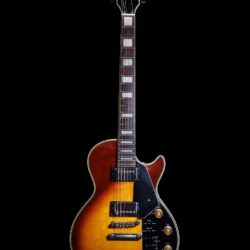
A Mysteriously Excellent Kay Effector
Guitar players today don’t know how good they have it. Inexpensive guitars imported from outside the U.S. are widely available, dependable, and high quality for the price. Folks in the ’60s and ’70s weren’t so lucky. Most instruments made at beginner-friendly price points by brands like Harmony and Kay were inferior to the Martins and Gibsons they copied, but a top-of-the-line Harmony had high-end features. Once you started looking at models with fancy inlays and multiple pickups, some cost even more than low-end and mid-priced Gibsons. As the popularity of the guitar soared, so did the demand for even cheaper options. Harmony and Kay couldn’t keep up, and American importers noticed an opportunity in Japan. But as the yen gained strength, importers started looking for even lower-cost manufacturing and found it in Korea.A young company called Samick sprang into action. Originally an importer of Baldwin pianos, they rapidly expanded their production capabilities with a factory able to make one-million instruments per year. Great news for American importers, but perhaps less great news for American guitar beginners. The market was soon flooded with Korean guitars still in their trial-and-error era. Truss rods were non-adjustable decoration. The finishes were no match for the heat and humidity of container ships. Hardware made from cheap die-cast aluminum was prone to snapping in half. Needless to say, early Korean guitars developed a bad reputation.So when this Samick-made Les Paul copy came through the doors of Fanny’s House of Music, expectations were low. The floppy-looking bolt-on neck and blank headstock trigger a trauma response in guitarists of a certain age. But once you try it, all the bad experiences melt away like so much nitrocellulose on a container ship. The action is extremely low at 2/32″, but it somehow still has “resistance” that feels so good—the kind that lets you dig in and get a different sound. The frets are worn but well cared for. Whoever used to own this beauty didn’t let it go too long without a crowning.“Everything about it, we were like, ‘Wait, this shouldn’t be this good!’” Fanny’s owner Pamela Cole says, with a laugh.Kay went under in the late ’60s, and its assets were auctioned off in 1969. The rights to the name were acquired by an importer called Weiss Musical Instruments, whose primary brand was Teisco del Ray. Calling their guitars “Kay” gave them more credibility with dealers, even if the guitars were essentially Teisco del Reys with a different name on the headstock. They certainly didn’t resemble the old Kays one bit. “The hardest thing about adding a 3-way switch would be finding the real estate.”In the Sears catalogue, this model was called the Kay Effector. Its flight-deck-esque array of switches and knobs sits atop a spaghetti plate of cables and components. There are two single-coil pickups in humbucker-sized housing, which are both always on. There’s no pickup selector. Intrepid modders take note: The hardest thing about adding a 3-way switch would be finding the real estate. Included in the flock of switches are one that flips the pickups out of phase (hip!) and one that turns the built-in effects on and off. Only one of the Effector’s effects feels familiar: The fuzz has a Muff-like quality but is more of a distortion than a fuzz. The four modulation effects—echo, tremolo, wah, and the intriguingly-named “whirl wind”—sound similar once you start playing around with them. A poke around the schematic reveals why: All the modulation effects work off the same 2N2646 unijunction transistor, which mega-nerds may recognize from the classic Vox Repeat Percussion. In fact, each modulation effect is the same, hitting different capacitors along the way to give each one a subtly different sound. This author enjoyed “whirl wind” the best, partly because it had the most fun name, but also because it had a dynamic, “reverse-sawtooth” feel.Guitars like this Samick-made Kay Effector are artifacts from a transitional moment in gear history, when manufacturers were learning on the job and players were beta testers. A guitar that once felt like a compromise now feels like a hidden gem. It’s a reminder that innovation and excellence don’t always come from the top shelf. Perhaps the weirdest instruments are some of the best; they just never had a chance to be taken seriously.
Read more »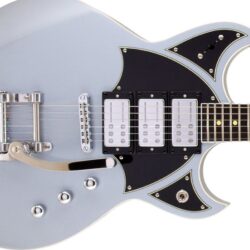
Reverend Guitars Launches Bold New Spacehawk Supreme
Three pickups, seven combinations, endless sonic optionsReverend has unveiled the Reeves Gabrels Spacehawk Supreme, the latest version of the innovative Reeves Gabrels Spacehawk.The new model sports three Railhammer pickups: an Alnico Grande at the bridge, a Hyper Vintage in the middle position, and a Hyper Vintage at the neck. Packed with features, the Spacehawk Supreme offers a bevy of switching options to supplement its 5-way pickup selector. The Reverend Studio Switch adds the bridge pickup (push-pull volume knob) allowing a total of seven pickup combinations, plus the guitar provides a push-pull phase switch in the tone knob. Last, but not least, the guitar features a kill toggle for instant on-off. Sporting a Bigsby tremolo, the Spacehawk Supreme is available in two eye-grabbing finishes: Metallic Silver Freeze or Venetian Gold.The Reverend Spacehawk is the guitar that Reverend Guitars designed for Reeves Gabrels when he joined The Cure. It is the sixth signature model for Gabrels from Reverend Guitars.Reverend’s new Reeves Gabrels Spacehawk Supreme carries a street price of $1699. For more information visit reverendguitars.com.
Read more »Video Premiere: Undead – “This Side of the Grave”
WATCH: Death dealers Undead wake up on the right side of the grave.
The post Video Premiere: Undead – “This Side of the Grave” appeared first on Decibel Magazine.
Witchcraft – Witchcraft
Witchcraft Hall of Fame, take one.
The post Witchcraft – Witchcraft appeared first on Decibel Magazine.
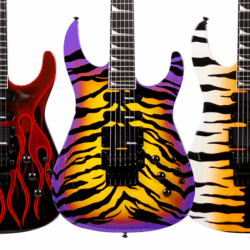
Badlands Guitar Company Unveils the Limited Edition GX1-PRO Guitar
Limited to only 100 pieces, Badlands Guitar Company announces the release of its USA made GX1-PRO, available August 1 direct from the factory or at select retailers.Purpose-built for players who came of age in the golden era of 1980s rock and metal, the GX1-PRO channels the high-octane spirit of that decade with custom-shop precision and modern performance refinements. Built exclusively in Maryland and available in either right or left-handed configurations, these arena rocking instruments fuse aggressive styling with hand-selected components for players seeking tone, playability, and attitude in equal measure.The GX1-PRO features an alder body and a three-piece, quarter sawn maple neck-thru design, reinforced with carbon fiber rods and a dual-action truss rod to ensure exceptional sustain and resonance. The Custom series offers hand-painted finishes including Mystic Blue HotRod, Inferno Red HotRod, Sunset Bengal, and Retro Bengal. Available in the Classic series are solid finishes including Midnight Blue, Arrest Me Red, Taxi Yellow, and White Wedding Pearl. All finishes are polyurethane and an unmistakable homage to the high-octane visual style of the 80s. The 25.5” scale, ebony fretboard is loaded with 24 Jescar nickel silver frets and shaped with a compound radius of 12”-16”. Finished in matching paint, the ‘80’s select neck profile and 1 11/16” nut width provides comfort and easier playability. A tilt back headstock and Sperzel locking tuners improve sustain and tuning stability while Badlands Guitar Company’s signature mother of pearl “Railroad Spikes” inlays and white binding add a touch of classic elegance.Just like any hot rod, custom paint is only half of the equation. What is under the hood is always what matters most. The GX1-PRO is engineered for powerful, versatile tones. Loaded with an H/S/S configuration, the custom-designed, handwound BGC M89 ceramic humbucker in the bridge position meticulously delivers an aggressive growl reminiscent of the era’s most iconic high-performance pickups. This is perfectly complemented by two specially voiced BGC M81 single coils. The control layout features a trio of mini toggle switches, offering a wide array of tonal shaping options, consistent with classic 80s setups. A newly developed BGC1200M Midboost circuit, a first for Badlands Guitar Company, further expands the guitar’s sonic palette, allowing players to dial in a diverse range of sounds from searing leads to articulate rhythm tones. The USA Floyd Rose bridge, locking nut, metal knurled knobs, and football jack cover are all appropriately finished in black.Each GX1-PRO arrives set up with SIT Strings and ships with a premium embroidered Badlands G&G case, ensuring secure transport and protection. Case candy includes a Certificate of Authenticity, QC card, VIP Backstage Pass lanyard, pin and sticker set, a Dunlop System 65™ Multi-tool, and a limited edition framed poster uniquely matching the very guitar ordered.For more information, please visit www.badlandsguitarcompany.com.Street Price:GX1-PRO Custom HSS $3499.00 USDGX1-PRO Classic HSS $2999.00 USD
Read more »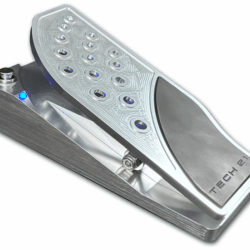
Tech 21 Killer Wail v2 Review
Tech 21’s original Killer Wail was an under-the-radar wah that gathered a great reputation among those in the know. After a complete redesign, Tech 21 released the Killer Wail v2, as well as two other wahs—the Richie Kotzen Signature wah and the Killer Blue Wail (for bassists). These are a significant departure from the original Killer Wail.Machined from solid billet aluminum, the Killer Wail v2 is sturdy yet light. In fact, my Cry Baby weighs more than twice as much. It’s sleek—almost aerodynamic if such things were a consideration for wah pedals—with little of the bulk associated with conventional wahs. With its compact footprint and top-mounted jacks it’s also pedalboard friendly, a claim few wahs can make. It can also be operated via a 9V battery or DC power supply.A Wah for Modern TimesA nice vintage wah exudes, well, mojo. That’s the nature of the effect, and a fact we can probably all agree on. But the mechanics of most wah designs come with downsides. The majority of wahs (vintage and modern) employ pots that tend to get noisy and scratchy, and if used heavily will ultimately need replacement. The Killer Wail v2 eliminates these issues by using a light sensor instead of wah pots. Theoretically, the light sensor will almost never wear out. This isn’t a new solution—Morley’s beastly chrome wahs from the 1970s famously employ optical sensors, and continue to do so. But they are a very practical—and quiet—alternative to conventional filter pots that tend to act like dust magnets.Tech 21 also equips the wah with a silent buffered bypass switch positioned at the top left corner. A blue light beneath the button glows red when the pedal is engaged. According to Tech 21, the actuator is rated for a million uses, so durability shouldn’t be a concern.
The Killer Wail v2’s proprietary filter delivers a distinct feel. As expected, toe-down boosts the highs—but even without distortion, your tone stays rich and warm while still slicing through a band mix. Add a drive pedal after the wah, and that tonal character pays big dividends, yielding biting, aggressive, and warm tonalities that are ideal for screaming solos.Heel-down, the pedal boosts the low end, creating a softened attack that lends sustained chords an almost Fender Rhodes-like feel. Engaging a drive pedal brought out creamy, vocal-like lead tones. Placing gain pedals before the wah allowed for slightly glitchy, synth-like sounds on single-note lines, in addition to more conventional percussive wah textures.The Killer Wail v2 may not be the most budget-friendly wah out there, but its combination of long-term durability, expressive tone, and smooth, natural sweeps makes it feel like a solid investment—from heel to toe.
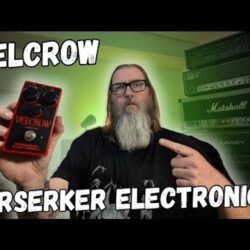
Berserker Electronics Launches the “Velcrow”
A fierce and flexible Gated Fuzz for modern players.Berserker Electronics, creators of the Prehistoric Dog preamp and Aquanaut delay, has announced the release of their latest sonic weapon: Velcrow – a raw, percussive gated fuzz pedal designed for players who crave filthy textures with tight control.Inspired by the beloved and discontinued Way Huge Conquistador, the Velcrow takes that sputtery, aggressive sound and pushes it further – offering more dynamic range, more usable tones, and a sharper, more responsive gate. Velcrow is built to deliver snarling fuzz with a snappy gate, thriving on punchy riffs, abrupt cutoffs, and glitchy sustain.Despite its intensity Velcrow is also intuitive to dial in, with carefully tuned controls that let you shape your attack and decay without ever sounding flabby or buried.Key features include:Inspired by the Way Huge Conquistador, but with expanded range and controlTightly gated fuzz with sharp attack and fast decaySimple, intuitive controls in a pedalboard-friendly enclosureThe Velcrow is available direct at www.berserkerpedals.com. Street price is $129.
Read more »